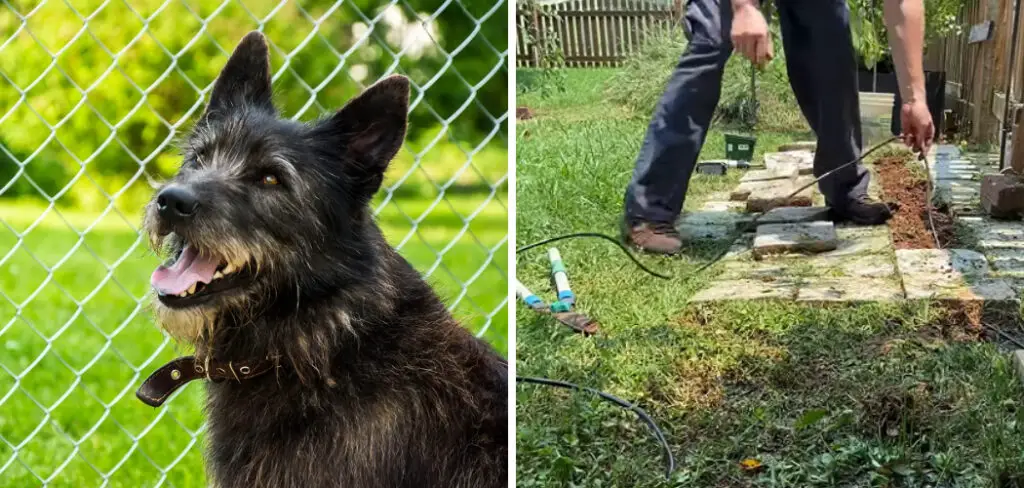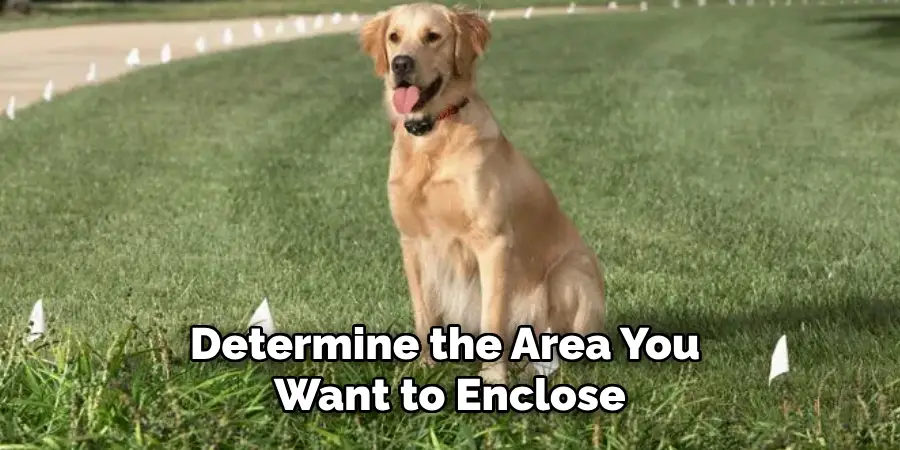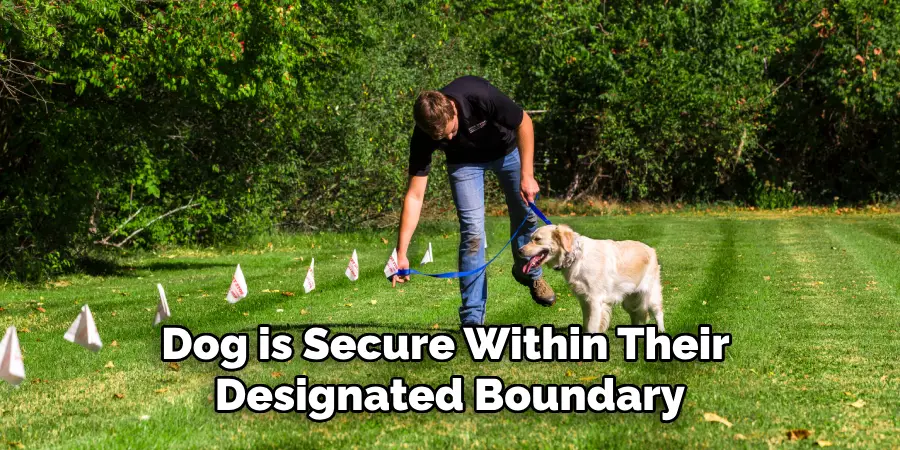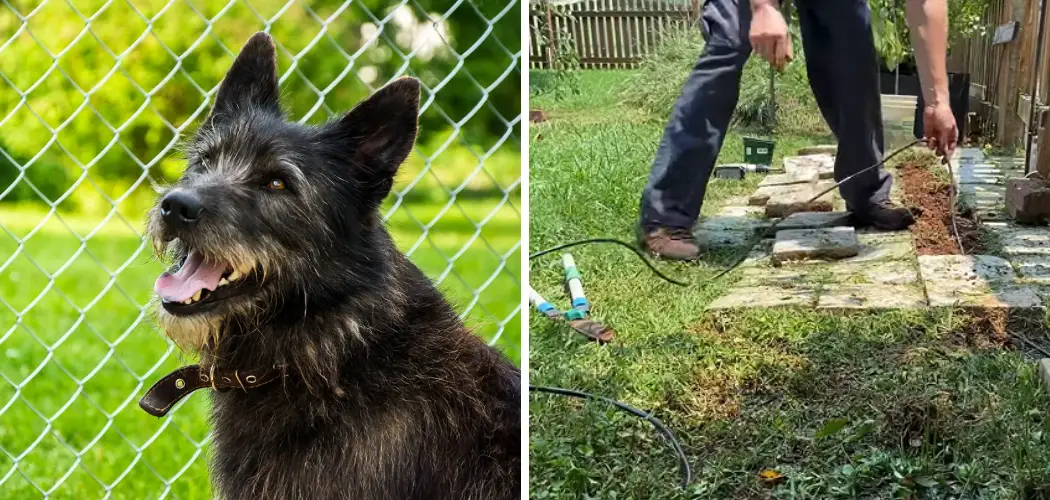Installing an above-ground electric fence for dogs is a great solution for pet owners who want to keep their furry friends safe and secure within a designated boundary. This type of fencing uses a low-voltage shock to train your dog to stay within the perimeter without causing any harm.

It is also an affordable alternative compared to traditional fences, making it a popular choice among pet owners. In this guide, we will walk you through the necessary steps on how to install above ground electric fence for dogs and ensure the safety and security of your beloved pet.
Understanding Above-Ground Electric Fences
Before we dive into the installation process, it is important to understand how above-ground electric fences work. These fences consist of a transmitter, receiver collar, and boundary wire that creates an invisible perimeter around your yard or designated area.
When the dog wearing the receiver collar gets close to the boundary wire, they will receive a warning beep followed by a mild shock if they continue to approach the boundary. This trains the dog to stay within the designated area, and over time, they will learn to avoid the perimeter altogether.
Tools and Materials You Will Need to Install Above-Ground Electric Fence for Dogs
1. Above-ground electric fence kit (includes transmitter, receiver collar, and boundary wire)
2. Wire cutters
3. Pliers
4. Garden hose or spray paint
5. Shovel
6. Trencher (optional but recommended for larger yards)
7. Boundary flags (to mark the perimeter)
8. Training flags (optional but recommended for initial training)
Step-by-step Guidelines on How to Install Above Ground Electric Fence for Dogs
Step 1: Plan and Measure the Area

The first step is to determine the area you want to enclose with the electric fence. Use a garden hose or spray paint to mark the perimeter of your desired boundary. Make sure to keep at least 6-10 feet of clearance between the boundary wire and any physical barriers (e.g., fences, walls, trees) to avoid interference. This area will serve as a guide for laying the boundary wire.
Step 2: Install the Transmitter
Next, find a suitable location for the transmitter. It should be in an indoor or sheltered area near a power outlet and away from any water sources. The transmitter should also be out of reach of children and pets to avoid any tampering. Follow the manufacturer’s instructions to mount the transmitter on a wall or set it on a flat surface.
Step 3: Lay and Bury the Boundary Wire
Using the marked perimeter as a guide, use a shovel or trencher to dig a shallow trench (approximately 2-3 inches deep) along the boundary line. The trench should be wide enough to fit the boundary wire comfortably. Begin laying the wire, making sure to follow any specific instructions or guidelines provided by the manufacturer. Once the wire is in place, bury it using a garden tool or by backfilling the trench with dirt.
Step 4: Install and Test the Receiver Collar
Attach the receiver collar to your dog’s neck and adjust it according to their size. Make sure to leave enough room for a finger to fit between the collar and your dog’s neck. Turn on the receiver and verify that it is working correctly by walking towards the boundary wire. The collar should beep, indicating that it is receiving a signal. If everything is functioning correctly, turn off the receiver until you are ready for training.

Step 5: Train Your Dog
Training your dog is a crucial step in the installation process. Start by placing boundary flags around the perimeter to serve as visual markers for your dog. Then, walk your dog on a leash towards the boundary wire and observe their reaction when they hear the warning beep or receive a shock. Repeat this process several times until your dog learns to avoid the perimeter and respond to the warning signals. It is essential to be patient and consistent during this training phase.
Step 6: Monitor and Adjust
After the initial training, it is vital to monitor your dog’s behavior and make any necessary adjustments. For example, if your dog continues to cross the boundary despite receiving a shock, you may need to increase the shock intensity or adjust the boundary width. Additionally, regularly check the boundary wire for any damage or interference and make repairs when necessary. If you have multiple dogs, make sure each one has their receiver collar to prevent confusion.
Following these steps will ensure a successful installation of an above-ground electric fence for your dog. Remember to always prioritize the safety and well-being of your pet by regularly checking the fence and providing proper training. With this type of fencing, you can have peace of mind knowing that your dog is secure within their designated boundary while still having the freedom to roam around and play. Happy installing!

Additional Tips and Tricks to Install Above-Ground Electric Fence for Dogs
1. If you have multiple dogs, make sure to consider them all when designing and installing your electric fence. Consider the size, temperament, and behavior of each dog to ensure that they are all safely contained within the boundaries.
2. Once installed, it is important to regularly check and maintain your electric fence for any damages or malfunctions. This includes inspecting the wires, posts, and control box, as well as replacing any dead batteries. Regular maintenance will ensure that your fence continues to effectively contain your dogs.
3. If you have an extra energetic or determined dog, consider installing a double-loop electric fence. This involves placing two wires side by side, creating a stronger and more reliable barrier for your dog.
4. To prevent unintentional shocks, make sure to mark the boundaries of your electric fence with flags or other visible markers. This will also help your dogs learn and remember the boundaries more quickly.
5. Consider using a combination of training and positive reinforcement along with your electric fence to teach your dogs the boundaries. This can include using treats, praise, and consistent commands to reinforce their understanding of the fence’s boundaries.
6. If you have any concerns about the safety of an electric fence for your dogs, consult with a professional or veterinarian. They can provide valuable insight and advice on how to safely install and use an electric fence for your specific needs.
7. Make sure to regularly test the shock level of your electric fence to ensure that it is not too high or too low for your dogs. This will help prevent unnecessary harm or discomfort for your pets.

8. Consider purchasing a wireless electric fence for added convenience and flexibility. These fences use GPS technology to create a virtual boundary without the need for physical wires or posts.
9. When setting up your electric fence, make sure to keep it at least 10 feet away from any water sources, such as pools or ponds, to prevent electrical hazards for your dogs.
10. Lastly, always supervise your dogs when they are outside in the electric fence area. While electric fences can be effective containment systems, it is still important to monitor your dogs for any potential safety risks or escape attempts.
By following these additional tips and tricks, you can ensure that your above-ground electric fence for dogs is installed and utilized safely and effectively. Remember to prioritize the safety and well-being of your dogs at all times. So, they can enjoy their outdoor space without any harm or discomfort.
Experiment with different techniques and methods to find what works best for your specific situation and dogs. With proper installation, regular maintenance, and responsible usage, an electric fence can be a great solution for keeping your furry friends safe and contained while still allowing them the freedom to roam and play in your yard. Happy fencing!
Things You Should Consider to Install Above Ground Electric Fence for Dogs

1. The first thing to consider is the size of your dog. The bigger the dog, the higher you should install your electric fence. You want to make sure that your dog cannot jump or climb over the fence.
2. Another important factor is the location of your fence. Make sure it is placed in an area with enough space for your dog to roam and play, but also keep in mind any potential hazards such as nearby roads or bodies of water.
3. It is also crucial to consider the voltage and power of your electric fence. Different dogs may have different levels of tolerance for electric shocks, so it is important to choose a fence with adjustable settings.
4. You should also think about the type of wire or cable used in your electric fence. Some wires are more durable and weather-resistant than others, so consider the climate and environment in which you live.
5. When installing your electric fence, be sure to follow all instructions carefully and take necessary safety precautions. This includes wearing protective gear, making sure the power is off when handling wires, and properly grounding the fence.
6. It is important to regularly check and maintain your electric fence to ensure it is functioning properly. This includes checking the wires for any damage, making sure the power source is working correctly, and trimming any vegetation that may interfere with the fence.
7. You should also consider training your dog to become familiar with the electric fence and its boundaries. This can help prevent any accidents or escape attempts.
8. Additionally, make sure to inform your neighbors and anyone who may come into contact with your dog about the presence of an electric fence. This can help avoid any misunderstandings or potential harm to others.
9. Lastly, consider any additional features that may benefit you and your dog, such as a remote control for turning the fence on and off, or a warning system that alerts you when the power is low.
Following these considerations can help ensure a safe and effective installation of an above-ground electric fence for your dog. Remember to always prioritize the safety and well-being of your pet when making any decisions regarding their containment. Happy fencing!

Troubleshooting Common Issues to Install Above-Ground Electric Fences for Dogs
1. Dog Resistant to the Collar:
One of the most common issues with above-ground electric fences for dogs is when the dog is resistant to wearing the collar. This can happen due to various reasons such as discomfort, fear, or improper training.
To troubleshoot this issue, first, ensure that you have chosen a comfortable and properly fitting collar for your dog.
You can also try gradually introducing the collar to your dog, starting with short periods of wear and increasing it. Additionally, make sure to properly train your dog on the purpose and function of the collar. Consistent positive reinforcement can also help in getting your dog accustomed to the collar.
2. Incorrectly Set Boundary:
Another common issue with above-ground electric fences is when the boundary is not set correctly, leading to either false alarms or allowing the dog to escape. To avoid this problem, carefully follow the installation instructions provided by the manufacturer. Make sure to properly measure and mark the boundaries before installing the fence. Test the boundary by walking along it with the collar to ensure it is working accurately. If needed, adjust and reposition the fence.
3. Interference from Other Electronic Devices:
Sometimes, other electronic devices in your home or nearby can cause interference with the electric fence’s signal, resulting in malfunction or false alarms. To troubleshoot this issue, first, identify any potential sources of interference such as wireless routers, microwaves, or power lines. Try to keep the electric fence unit away from these devices and their antennas. You can also try using a different frequency setting on the electric fence unit.
4. Weak Battery or Power Source:
If your electric fence is not functioning correctly, it could be due to a weak battery or power source. Make sure to regularly check and replace the batteries in the collar as needed. If your electric fence unit is connected to an outlet, ensure it has a steady power supply. In case of a power outage, have a backup plan in place, such as using a battery-powered unit.
5. False Alarms:
False alarms can be frustrating for both you and your dog. They can be triggered by various factors such as environmental interference, faulty equipment, or incorrect settings. If you are consistently experiencing false alarms, first check if there is any physical damage to the fence or collar. Then, adjust the sensitivity level on the electric fence unit to reduce false alarms. If the issue persists, contact the manufacturer for further assistance.
Following these troubleshooting tips can help you address common issues that may arise while installing an above-ground electric fence for your dog. Remember to always follow the manufacturer’s instructions and consult a professional if needed. With proper installation and training, your electric fence will provide a safe and effective containment solution for your furry companion. Happy fencing!

Frequently Asked Questions
Do I Need to Follow Any Precautions While Installing the Fence?
Safety should always be your top priority when installing any kind of fence. Before starting, make sure to turn off the power supply to avoid any accidents. Also, wear protective gear such as gloves and safety glasses to prevent injuries. If you have any doubts or concerns, it’s best to consult a professional for assistance.
How Deep Should I Bury the Wires?
The depth of wire burial can vary depending on different factors such as soil type and moisture levels. Generally, the wires should be buried at least 1-3 inches underground to protect them from damage caused by lawn equipment or other outdoor activities. However, it’s recommended to refer to the manufacturer’s instructions for specific depth requirements.
Can I Install the Fence by Myself or Do I Need Professional Help?
While above-ground electric fences are relatively easy to install, it’s always a good idea to seek professional help if you’re unsure about any step of the process. Professionals have the necessary expertise and equipment to ensure the installation is done correctly and safely. In addition, they can also provide valuable advice on maintaining and troubleshooting your electric fence.
How Do I Maintain and Troubleshoot My Electric Fence?
Regular maintenance is crucial for ensuring the effectiveness of your electric fence. Inspect the wires and connections periodically to make sure they are in good condition. Remove any debris or vegetation that may interfere with the fence’s function. In case of a malfunction, start by checking the power source and replace any damaged wires or components as needed. If the issue persists, it’s best to contact a professional for further assistance.
Can I Use an Electric Fence for Any Type of Animal?
Electric fences can be used to contain various types of animals such as horses, cattle, sheep, and even pets like dogs. However, it’s important to choose the right kind of electric fence and adjust the settings according to the animal’s size and behavior. For example, a lower voltage setting may be suitable for smaller animals while larger animals may require a higher voltage.
Conclusion
Now you know how to install above ground electric fence for dogs or any other animal! Remember to prioritize safety, consult a professional if needed, perform regular maintenance, and adjust the settings according to your specific needs. With proper installation and care, your electric fence will effectively contain your animals while keeping them safe and secure. Happy fencing!
About
Outdoor Fixes is a distinguished figure in the world of Diy design, with a decade of expertise creating innovative and sustainable Diy solutions.
His professional focus lies in merging traditional craftsmanship with modern manufacturing techniques,
fostering designs that are both practical and environmentally conscious. As the author of diy,
outdoorfixes delves into the art and science of outdoorfixes-making, inspiring artisans and industry professionals alike.
Education RMIT University
(Melbourne, Australia) Associate Degree in Design (Outdoor Fixes) Focus on sustainable design, industry-driven projects,
and practical craftsmanship. Gained hands-on experience with traditional and digital manufacturing tools, such as CAD and CNC software.
Nottingham Trent University
(United Kingdom) Bachelor’s in outdoorfixes.com and Product Design (Honors) Specialized in product design with a focus on blending creativity with production
techniques. Participated in industry projects, working with companies like John Lewis and Vitsoe to gain real-world insights.
Publications and Impact
In diy, Outdoor Fixes his insights on indoor design processes, materials, and strategies for efficient production.
His writing bridges the gap between artisan knowledge and modern industry needs, making it a must-read for both budding designers and seasoned professionals.

